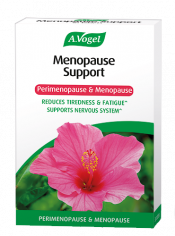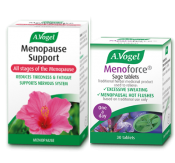Read the full video transcript below
Today's topic
Hello, and welcome to my weekly video blog. And today on A.Vogel Talks Menopause, I'm going to be talking about leg problems in the menopause.
These are so common. I get lots of women on a regular basis e-mailing me and wanting to know if things like achy legs, leg cramps, swollen ankles, restless legs or hot feet are menopause symptoms. Yes, they can be, and there are four main reasons why these symptoms can occur. So I'm going to go over those four today.
Issue 1: Magnesium deficiency
The first one is magnesium deficiency. Now, we know that falling oestrogen can affect the absorption of magnesium and that can have a detrimental effect on lots of different areas in the menopause.
We know, too, that poor diet can cause magnesium deficiency, and we also know that stress will burn magnesium up like no one's business, so magnesium deficiency is really common in the menopause.
Leg problems caused by magnesium deficiency
The types of symptoms you'll get with magnesium deficiency would be things like cramps, especially at night. You'll get those restless legs, you know, there you are just dropping off to sleep and suddenly, your legs are dancing all on their own. It can be really painful, and it can take a long time to settle down. You can get pins and needles, and you can get jumpy legs as well.
What can help?
Now, the main way to sort these would be getting a magnesium supplement. I would suggest either a powdered magnesium that you can dissolve in water, you can take that just before bed if you want, tablets, if you're taking a magnesium tablet, are best taken with your evening meal.
For leg cramps especially, there is a tissue salt that you can take called Mag Phos, and this is another one that you can take right before you go to bed.
Make sure that your diet is rich in magnesium foods. There'll be a link here on the page, so we'll take you to a list of all the lovely magnesium-rich foods that you can add into your diet.
Issue 2: Fluid imbalance
Now, number two cause is fluid imbalance. We know that falling oestrogen can interfere with the hormones that control the water balance in the body, which means you can get dehydrated absolutely anywhere as you go through the menopause and very often, you're not even aware of this particular problem.
So low oestrogen causes it. Very few people are drinking enough water in this day and age, it's all tea, and coffee, and fizzy drinks, and fruit juices. It can also be the fact that you're getting hot flushes and night sweats. That would dehydrate you as well, and that will interfere with your whole water balance.
Leg problems caused by fluid imbalance
So what's likely to happen in this instance is you're likely to get swollen ankles, swollen legs. You can get achy tired legs. This can be a contributory factor to hot feet and general dehydration, just as a little aside it's not to do with the legs, but general dehydration can also cause breast pain as well, so for this particular one, make sure that you're drinking more than enough water, over and above anything else you're drinking during the day as well.
What can help?
You can look at our Golden Rod Tea, which is a lovely one for water retention. The only thing I would say here is if your swollen ankles and swollen legs are there all the time, then please get this checked out by your doctor first, because it could indicate other health issues such as blood pressure problems.
Issue 3: Circulatory problems
Number three cause is general circulation. Your circulation can deteriorate in the menopause, again, it can be falling.
Oestrogen can make your circulation that bit more sluggish. It can also be to do with the fact that we live a more sedentary life, a lot of us, we're having jobs, we're not moving about as much, and that can affect circulation in the legs.
It can also be fatigue. If we're really fatigued, we're not going to want to exercise and do maybe a nice little bit of brisk walking once a day. And dehydration can be a factor, too. If you're dehydrated, that can interfere with your circulation.
Leg problems caused by circulatory problems
So this particular one, the problems, again, are going to cause things like swollen ankles and swelling legs. You're going to get tired legs, you're going to get hot legs, you're going to get restless legs, and possibly end up with varicose veins as well.
What can help?
So for this one, again, we're looking at loads of water. Don't forget the water. If you're getting the start of varicose veins, if you're getting swollen ankles, you can look at our Venaforce tablets or our Venagel as well, which you can put that in the fridge.
It's lovely during the summer especially here in the UK, if we get a nice hot summer, then put it in the fridge and that will keep everything lovely and cool.
Issue 4: Structural issues
The fourth cause is structural problems. Now, we know that in the menopause our posture can change. It's all to do with the fact that our joints can be affected, that can pull on our posture, and that can cause problems with our legs as well.
It can be dehydration, too and believe it or not, if you're sitting at a desk all day, that can affect your shoulders, which in turn can affect your lower back, and your hips, and that can give you leg pain, and that could also give you swollen ankles as well. So any problems with your legs, just check your upper posture as well, and make sure that you're sitting up straight when you're at your desk.
Leg problems caused by structural issues
For this particular one, you're going to get general aches and pains. You might end up with pains in the knees, you might get ankle pains, you can get sore feet. You might find that when you're walking, that the soles of your feet start to get sore and you've never had that problem before, and as I mentioned before, you can end up getting sore hips and just general pain all over.
What can help?
So this one, it's about doing stretching exercise. It's about doing strengthening exercises. Maybe go and see a chiropractor if you've got a sore back. If you feel your posture is really bad you could look at the Alexander Technique. Exercising, such as Pilates and yoga, are absolutely fantastic for these sorts of things.
For localised pain areas such as your knees or your feet, you can also use the Atrogel as well.
So as you can see, just a small number of symptoms can be caused by quite a few different factors that can happen during the menopause. Hopefully, this has helped. Again, if you have any queries, then please do get in touch with me. And I'll see you next week for another edition of A.Vogel Talks Menopause.









